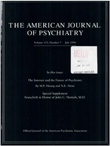Polysomnographic studies of unmedicated depressed men before and after cognitive behavioral therapy
Abstract
OBJECTIVE: Differentiation of stable, trait-like characteristics from more episodic or state-dependent disturbances will be helpful in gaining a better understanding of the pathophysiology of depression. However, research in this area has been complicated by artifactual and clinical problems associated with pharmacologic treatment. In this investigation the authors used EEG sleep studies to assess medication- free depressed male patients before and after cognitive behavioral therapy. METHOD: Forty-five male patients with the diagnosis of major depression according to the DSM-III-R criteria and the Research Diagnostic Criteria underwent EEG sleep studies before and after 16 weeks of cognitive behavioral therapy, during which they were free of medication. In addition to the documentation of changes within these patients, the findings were compared with those for 47 healthy subjects, including 15 who were restudied 12-24 months after their baseline assessments. RESULTS: The EEG sleep profiles of the depressed patients showed a significant reduction in REM sleep density after treatment, suggesting "normalization" of an abnormal state-dependent process. By contrast, slow wave sleep and tonic REM measures, including reduced REM latency, were unchanged after treatment. CONCLUSIONS: These findings suggest that early in remission there is disaggregation of irreversible, trait-like correlates of depression (e.g., diminished slow wave sleep and reduced REM latency) from more reversible disturbances (e.g., increased REM density).
Access content
To read the fulltext, please use one of the options below to sign in or purchase access.- Personal login
- Institutional Login
- Sign in via OpenAthens
- Register for access
-
Please login/register if you wish to pair your device and check access availability.
Not a subscriber?
PsychiatryOnline subscription options offer access to the DSM-5 library, books, journals, CME, and patient resources. This all-in-one virtual library provides psychiatrists and mental health professionals with key resources for diagnosis, treatment, research, and professional development.
Need more help? PsychiatryOnline Customer Service may be reached by emailing [email protected] or by calling 800-368-5777 (in the U.S.) or 703-907-7322 (outside the U.S.).



